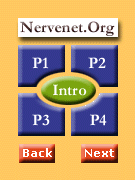




 |
 |
 |
 |
 |
|
|

|
|
||
|
EXPERIMENTAL PLAN |
|||
|
Principal Investigator/Program Director Williams, Robert W. |
|||
|
2. Changes to the underlying data structure We will therefore design and implement a custom image DB and integrate it into the MBL. The question as to the best overall architecture for an image database that will eventually hold about 100 GB of 2D images and 500+ GB of QT movies is still open. Technologies for database design and management are constantly evolving, as are specific tools for image database management. As an example, if we choose to employ FlashPix technology <www.flashpix.com/> we gain the ability to zoom in and out of images with ease and without loss of resolution. There are a number of commercial database products designed to handle FlashPix technology, and implementing one of these or creation of our custom database would be feasible. That being said, there is no certainty that this technology will be the best available at the time that the DB is being designed. During the first six months of the proposal, we will evaluate a range of software tools and image technologies before deciding on the platform for development of the image DB. Archiving Images with Greater Depth Although images in the current MBL are acquired at 12-bit depth, for reasons of storage space and speed of access they are saved as 8-bit images. We recognize the fact that users of the library may require higher-resolution images, perhaps even color, in order to address their research questions. One method of handling this issue is to archive high-resolution images off-line, and set up a system for users to request these images. We are uncertain whether these images can be eventually furnished online as the amount of data may preclude easy download. At the very least, we will be able to provide the ability to automatically order these images on CD-ROM or DVD-RAM online (see below). As mentioned above, FlashPix technology may well solve this issue in a more elegant way. FlashPix Format and imaging architecture is a relatively new way of efficiently representing pixel-based images. The technology behind FlashPix more efficiently displays images by breaking pixel-based images into more manageable pieces. In the case of the MBL, we would create an "original" image that could be viewed at different resolutions and magnifications. Thus, rather than storing three images to represent the view of a slide, we could store one image and then call up the different views on the fly. Additionally, changes to a FlashPix image are stored as "edit files" (text based) rather than as digitized images. This has enormous potential utility with regard to implementing displays of segmentation (Project 3) and image manipulation and analysis (see below). Finally, images saved in FlashPix format can be displayed and saved in virtually any common image format. Relating Other Databases to Image Database In addition to the creation of a true image DB, we need to modify the
existing DB to embrace the enhancements to the current MBL.
Specifically, we need to create a DB of QT movies and directly link that
to the individual cases and to their specific location on the sections
from which they are taken. Information concerning the segmentation of
regions of interest on the brain sections must also be incorporated
into the database structure. Finally, we will provide hooks in the
database to allow for the addition of other data as it comes online. For
example, as individuals begin to measure CNS traits and map QTLs, that
data will be stored in the database as well. In all cases, we will
optimize the overall data structure for flexibility and speed. The server running the MBL is currently a Macintosh G3. For the first two years of the project, we anticipate that the Macintosh platform will be sufficiently powerful to allow us to achieve our aims. It is a distinct possibility that the MBL may require more processing power than the Macintosh operating system can handle. In that eventuality, we will switch to a Linux (or other open-source system, such as Mac OS X) operating system and transfer the database to open-source software (e.g., My SQL). As with any database, care must be taken that the design is sufficiently flexible to allow for growth and modifications as new features are brought online. While we have done our best to carefully design the eventual architecture of the MBL, it is most certainly the case that we will be forced to deal with unanticipated additions and enhancements. Moreover, the database must be designed in such a way that migration to a different platform (e.g., Macintosh to Linux) is seamless. By using standard database programs that support SQL, Oracle, and ODBC standards, we can ensure future growth and compatibility.
|
|||
|
NEXT TOPIC |
|||